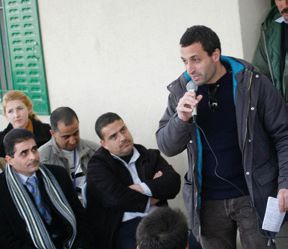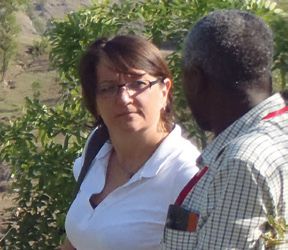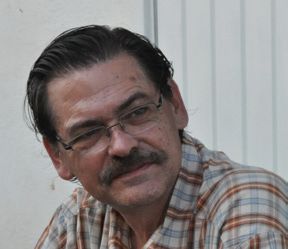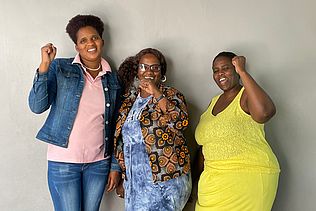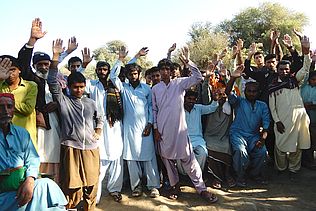In several important project regions, medico maintains its own offices to coordinate projects and service partnerships. Three office directors describe what they considered the most impressive local events in 2012.
Riad Othmann, Ramallah
{othmanjpg class="links"}In October 2012 I left the medico head offices in Frankfurt to take over the office for Palestine and Israel from my predecessor, Luke McBain. Luke had been supporting the still-pending litigation against the Israeli authorities about our solar and wind power installations. The dispute started end-2011 when the Israeli Civil Administration, the quasi-civilian arm of the military occupation of the West Bank, issued first stop-work orders and then demolition orders. medico had built the installations in the southern Hebron Hills with its Israeli partner organisation, Community Energy Technology in the Middle East (Comet-ME). There, they generate power for marginalised Palestinian communities denied access to the grid.
The German Federal Foreign Office, which had financed the installations, and its diplomatic representations intervened in the dispute with the Israeli occupying powers. Press coverage extended beyond Germany, and this finally helped inform a wider public about events in the so-called “C” regions, where Israel has sole control and is pursuing a policy of displacing the Palestinian population. Although none of our installations had been demolished by that point, the Civil Administration had refused to legalise installations or issue construction permits. Unfortunately, in the absence of pressure there is little prospect of any change in the Israeli position. Despite all these problems, our colleagues at Comet-ME succeeded in opening their small Centre for Renewable Energy near Hebron at the start of December, with numerous Israeli, Palestinian and international guests.
I was impressed not only by the persistence of medico’s partner but by the courageous people I met in Gaza who are opposing the internal and external blockade and fighting for freedom and human and civil rights. Majeda Al-Saqqah from the Culture and Free Thought Association and Issam Younis from the Al-Mezan Centre for Human Rights were keeping a concerned and analytical eye on developments in the Gaza Strip, relationships between Hamas and Fatah and Israel's policy. The brief war in November 2012, around three weeks after my arrival, was a week of worrying whether Israel would launch a land offensive as well, and of telephoning with colleagues under fire in Gaza and Khan Younis – all resulting right from the start in intensive exchanges which extended to some of our partners in Israel, such as the Physicians for Human Rights. As far as Gaza was concerned, I was a little shocked at myself: although I had already seen several times – for example, in Pakistan – that reality on the ground often had little in common with what the media was showing us, I had to thoroughly revise the images I had in my head. This learning process will take some time, the situation in the Gaza Strip is complex, with many layers. Fortunately, medico has partners who will help me in this, there, and in Israel and the West Bank.
Anne Hamdorf, Port-au-Prince
{hamdorfjpg class="links"}Early one morning in April 2012 we set off for our partner, Groupe Ecologique pour un Développement Durable en Haiti (GEDDH), located in Oranger, in the mountains in the interior of Léogâne, near the epicentre of the earthquake. We were very curious about what we would find there. GEDDH is one of medico's three partners in reafforestation projects in Haiti. Deforestation due to logging and erosion have continued to reduce the area of fertile land. To counter the resulting food insecurity and vulnerability to natural disaster, reafforestation is urgently needed.
The road led steeply upward, to the first view of the bare mountains. There are only a few places where small groups of trees are a distant reminder that Haiti was once thickly forested. Today, only two per cent remains. We go by the building site for the GEDDH health station and deep valleys which show the force of soil erosion. Here and there, we see signs of the first stabilisation measures which GEDDH members have built from stones and bamboo, with the help of the people. In recent weeks, the focus has been on mechanical soil conservation. From the summit, you can see the results. Everywhere, there are ditches excavated by our partner organisation and the people, designed to capture the soil carried away by the rain and prevent soil erosion. Freshly-planted seedlings from the small GEDDH nursery use these as a water reservoir.
These are small steps in the right direction, if uncertain and slow. Joseph, GEDDH's project manager, tells us that word is spreading about the project. Other local organisations have viewed the ditches in Oranger, and this simple but highly effective technique is already being transferred to other regions of Haiti. This is a successful example of the Haitian population recovering a little space and ability to act. And it is exactly moments like these which give them the motivation and strength to deal with what are in some cases very difficult processes, involving many setbacks.
Dieter Müller, Managua
{muellerjpg class="links"}For me, a special experience in 2012 was accompanying the caravan of relatives of migrants from Central America who disappeared in Mexico, getting to know the women and the few men who have not given up hope of finding their sons, daughters or spouses alive, who left in search of a somewhat better life for themselves and their families. The relatives courageously approach the authorities in Mexico, reminding them that their relatives in Mexico are not strays to be left to the mercy of corrupt officials and criminal bands to profit from. It is shocking and even scandalous that Mexico, which is demanding better treatment of its citizens in the USA, is treating its own neighbours to the south in this way. The reports and information that reach us repeatedly on the journey of over 4,000 km are horrifying and depressing.
I was also impressed by the many encounters – in hostels, on railway platforms, in public places – with the people from Guatemala, Honduras, El Salvador and Nicaragua who are crossing Mexico like hundreds of thousands before them. Their stories show the tragic realities of social exclusion and marginalisation, oppression, injustice and violence in their homelands. 'Why should we be put off by the risks in crossing Mexico or the US border when we're refused a life with dignity at home, or could be a victim of violence there any day?' asks a young man from Honduras.
On a positive note, there are many encounters with people and organisations that stand in solidarity with the migrants, supporting them in a wide range of engaged and creative ways, offering food and drink, a place to rest and regain their strength, medical or legal help. At the same time, they are taking a determined stand to get politicians and public opinion to acknowledge the right to migration free from violence. Increasingly, it is young people from all backgrounds who are becoming engaged here.

